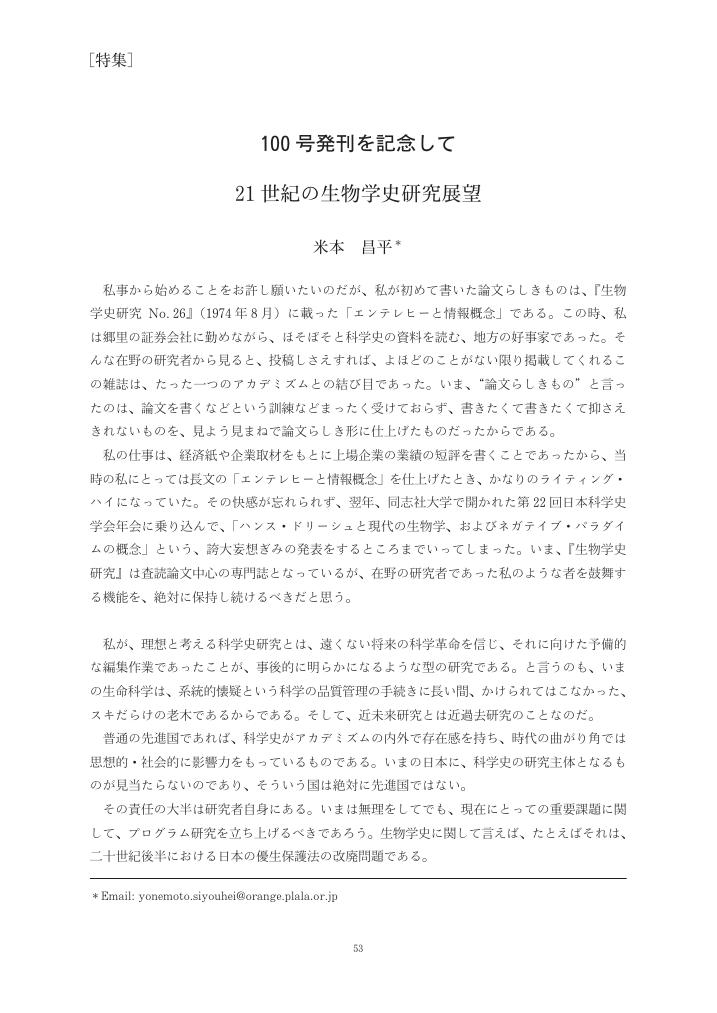3 0 0 0 OA 野口整体の史的変容 : 近現代日本伝統医学の倫理生成過程
- 著者
- 田野尻 哲郎
- 出版者
- 日本医学哲学・倫理学会
- 雑誌
- 医学哲学 医学倫理 (ISSN:02896427)
- 巻号頁・発行日
- vol.27, pp.1-12, 2009-10-01 (Released:2018-02-01)
Modern Japanese traditional medicine established in the mid-18th century suffered devastating damage due to the execution of the Medical Law (established in 1873) as an integral part Japan's modernization policies. Today, Japanese traditional medicine is a counterculture community on the periphery of modern mainstream medicine, whose practice changes in accordance with social changes. As a traditional medical movement, it has unique ethics that are constantly evolving. The traditional medical movement of a physical technique, which is known as "Noguchi-Seitai" and whose system and theory were established in 1927, passed through two transformation stages, one in 1956 and the other one in 1968. The movement become a community emerging concomitantly with medical techniques continuously alternating between a host and a guest, and the medical practice based on the psychosomatic transformations arose from self-training by the medical practitioner and the patient. Those transformations and generations are revealed from the conceptual viewpoint of "Education as Transformation" (Richard Katz, 1981).
2 0 0 0 OA 薬剤師を活用した医薬品リスクコミュニケーションの可能性の探索
- 著者
- 定松 淳 花岡 龍毅 田野尻 哲郎 田中 丹史 江間 有沙 廣野 喜幸
- 出版者
- 北海道大学 高等教育推進機構 オープンエデュケーションセンター 科学技術コミュニケーション教育研究部門(CoSTEP)
- 雑誌
- 科学技術コミュニケーション (ISSN:18818390)
- 巻号頁・発行日
- vol.21, pp.3-15, 2017-06
科学技術コミュニケーションの重要な課題のひとつとしてリスクコミュニケーションがあり(廣野 2013),そのなかでも一般市民にも広く接点のある領域として医薬品のリスクコミュニケーションがある.特に医薬品の副作用は身近で,重大なものになりえるにもかかわらず,その事実は社会的に十分認知されているとは言えない.医薬品リスクについてのコミュニケーションを活性化させ, リテラシーを向上させる必要がある.本稿では,医薬品についてのリスク情報を掌握している薬剤師の専門性に注目し,一般市民の薬剤師との関わりの実態についての探索的調査を行った.その結果から,医薬品リテラシーの向上のために薬剤師の専門性を活用する余地があること,その際には 前提としての「薬剤師が医薬品についての専門性を持っている」という点についての社会的認知を 高める必要があることを指摘する.これは,一般市民に対して知識の増進をつい求めてしまいがちな科学コミュニケーション一般に対しても,社会的なインデックス情報の重要性を指摘するものとして示唆するところが小さくないと考えらえる.
2 0 0 0 野口整体の史的変容 : 近現代日本伝統医学の倫理生成過程
- 著者
- 田野尻 哲郎
- 出版者
- 日本医学哲学・倫理学会
- 雑誌
- 医学哲学医学倫理 (ISSN:02896427)
- 巻号頁・発行日
- no.27, pp.1-12, 2009-10-01
Modern Japanese traditional medicine established in the mid-18th century suffered devastating damage due to the execution of the Medical Law (established in 1873) as an integral part Japan's modernization policies. Today, Japanese traditional medicine is a counterculture community on the periphery of modern mainstream medicine, whose practice changes in accordance with social changes. As a traditional medical movement, it has unique ethics that are constantly evolving. The traditional medical movement of a physical technique, which is known as "Noguchi-Seitai" and whose system and theory were established in 1927, passed through two transformation stages, one in 1956 and the other one in 1968. The movement become a community emerging concomitantly with medical techniques continuously alternating between a host and a guest, and the medical practice based on the psychosomatic transformations arose from self-training by the medical practitioner and the patient. Those transformations and generations are revealed from the conceptual viewpoint of "Education as Transformation" (Richard Katz, 1981).
1 0 0 0 OA 特集 100号発刊を記念して
1 0 0 0 OA 薬剤師による古方漢方の医療実践の分析
- 著者
- 田野尻 哲郎 花岡 龍毅 定松 淳
- 出版者
- 科学社会学会
- 雑誌
- 年報 科学・技術・社会 (ISSN:09199942)
- 巻号頁・発行日
- vol.30, pp.67-81, 2021-06-30 (Released:2022-07-01)

